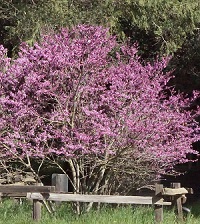There are many California native trees that work well in landscapes. Our locally native trees deserve to be cultivated more often in the San Francisco Bay area, and this list focuses primarily on them. They are well adapted to our climate and soils and provide special value for wildlife. For more information about these trees, please visit calscape.org.
Trees 20 Feet and Under
Blue Elderberry (Sambucus mexicana) is a fast growing deciduous tree with summer fruit that attract a wider range of birds than any other tree. Songbirds favor it highly for food and nesting. It is easy to grow and can adapt to both dry and moist conditions. It is very amenable to pruning.
 Western Redbud (Cercis occidentalis) is a deciduous tree that is covered in stunning pink flowers just before leaf emergence in the spring. It is a small tree - growing up to 20' and is fairly tolerant of a wide variety of soils, including clay. While not locally native, it grows well in the Bay Area. There are some beautiful specimens growing near the CNPS SCV Nursery at Hidden Villa in Los Altos Hills.
Western Redbud (Cercis occidentalis) is a deciduous tree that is covered in stunning pink flowers just before leaf emergence in the spring. It is a small tree - growing up to 20' and is fairly tolerant of a wide variety of soils, including clay. While not locally native, it grows well in the Bay Area. There are some beautiful specimens growing near the CNPS SCV Nursery at Hidden Villa in Los Altos Hills.
Arctostaphylos 'Dr. Hurd' (Dr. Hurd Manzanita) is a lovely choice if you need a small tree. While most manzanitas are closer to shrub in size, this is one of the tallest and can grow up to 15' tall (and wide). It originated in a garden in Portola Valley and does well in a wide variety of garden situations.
Ceanothus 'Ray Hartman' can grow up to 20' and is covered in beautiful blue flowers in early spring. It grows fairly quickly and is a good choice if you need a small, well-behaved tree. It can also be trained as a large shrub.
Western Mountain Mahogany (Cercocarpus betuloides) is found through much of the state. It can reach 15-20’. It can be trained into a single-trunked tree, but is often shrub-like in form with several main trunks when left to grow freely. In late spring, this small tree is covered with 1 - 2 inch long spiral seed heads which appear silver in the afternoon light.
The California Scrub Oak (Quercus berberidifolia) is a small oak that can reach up to 20'. However it grows very slowly, and is usually found as a small, compact shrub. A good choice for those who do not have the space for one of the larger oaks. Can be difficult to find in nurseries. Learn why it's important to plant oaks.
Trees Over 20 Feet
Valley oak (Quercus lobata) and coast live oak (Quercus agrifolia) grow fairly quickly and are easy to cultivate. Another wonderful local oak is canyon live oak (Quercus chrysolepis). This is the most widely distributed of our native oaks in California.While ancient trees which grew to maturity under summer dry conditions may resent summer irrigation, young oaks adapt to garden watering. Indeed, under garden conditions seedling oaks may reach 25 feet in ten years--they actually grow faster than many commonly planted trees! Learn why it's important to plant oaks.
Hollyleaf Cherry (Prunus ilicifolia) is an attractive evergreen tree with leaves that look similar to holly. It has pretty white flower clusters in the spring followed by small cherries with large pits that are popular with birds. It can grow up to 50' tall.
California Buckeye (Aesculus californica) is a beautiful tree with spectacular flower clusters in late winter and early spring. While it can grow up to 40' tall, it grows quite slowly, making it practical for even smaller gardens. Read this wonderful article about buckeyes by Roger Raiche to learn more about this lovely tree.
The California Bay Laurel (Umbellularia californica) becomes a stately evergreen tree that can reach 60'. Its fragrant leaves can be used in cooking (although in smaller quantities than its Mediterranean relative, the bay tree). It releases chemicals that supress other plants from growing, so it should not be siturated where understory plantings are desired.
The Pacific madrone (Arbutus menziesii) is one of the world's most beautiful broadleaf evergreen trees. It can grow up to 100', but is more commonly 25-40' in dry conditions. It be challenging to cultivate in a home garden, but it is a spectactular addition to the garden for those who are fortunate enough to grow it successfully.
Big-leaf maple (Acer macrophyllum) is very attractive, but it needs some moisture and does well when planted close to a water source. It can grow over 65' tall so be sure to plant it where there is enough space because it is fast growing in the right conditions.
The coast redwood is met with too often in cultivation locally. It does best when planted in cool areas with significant fog drip. The temptation to plant this tree in dry inland areas has resulted in many dead or dying trees. Unless you live in an area where these trees grow naturally, resist the urge to plant one.

